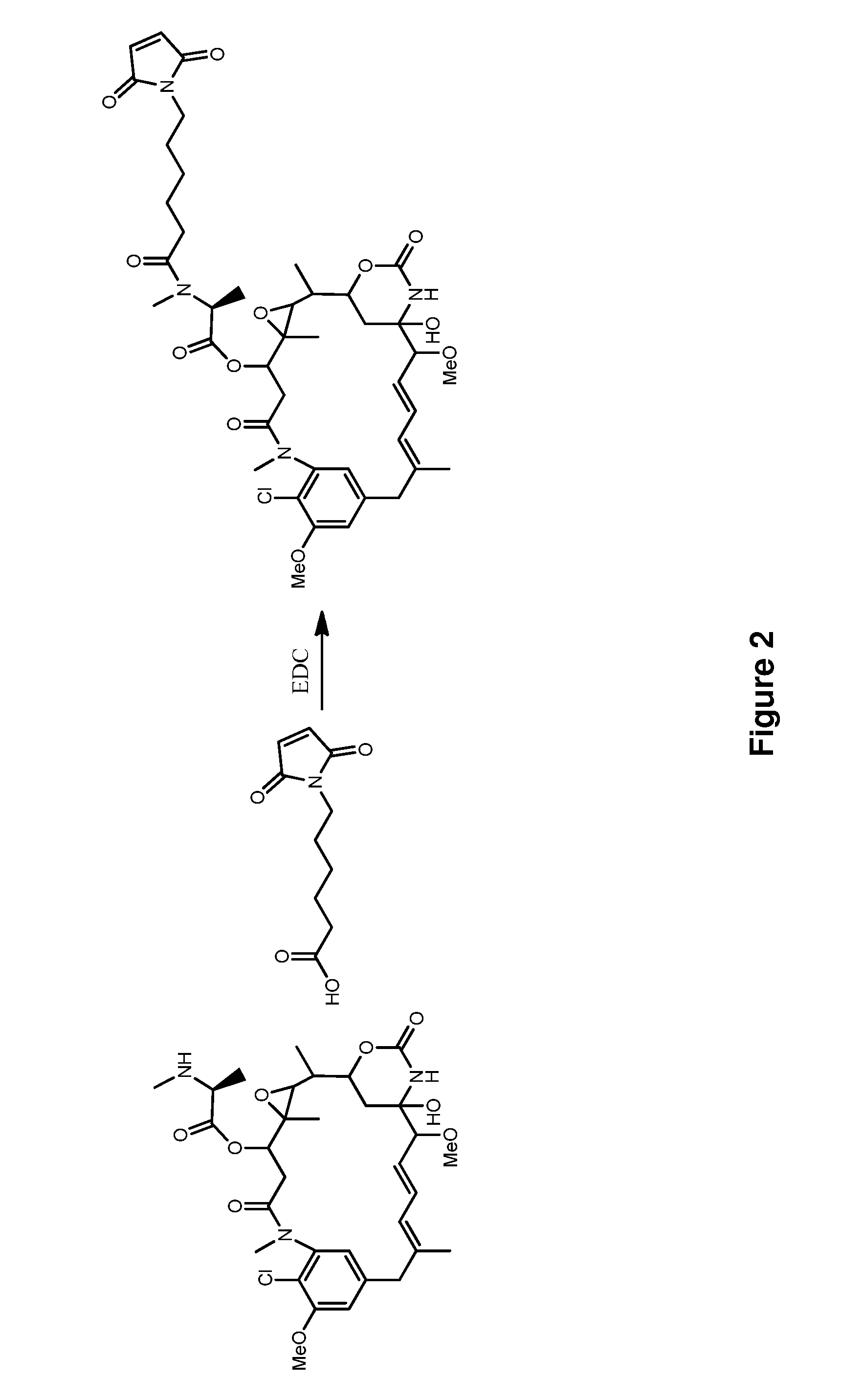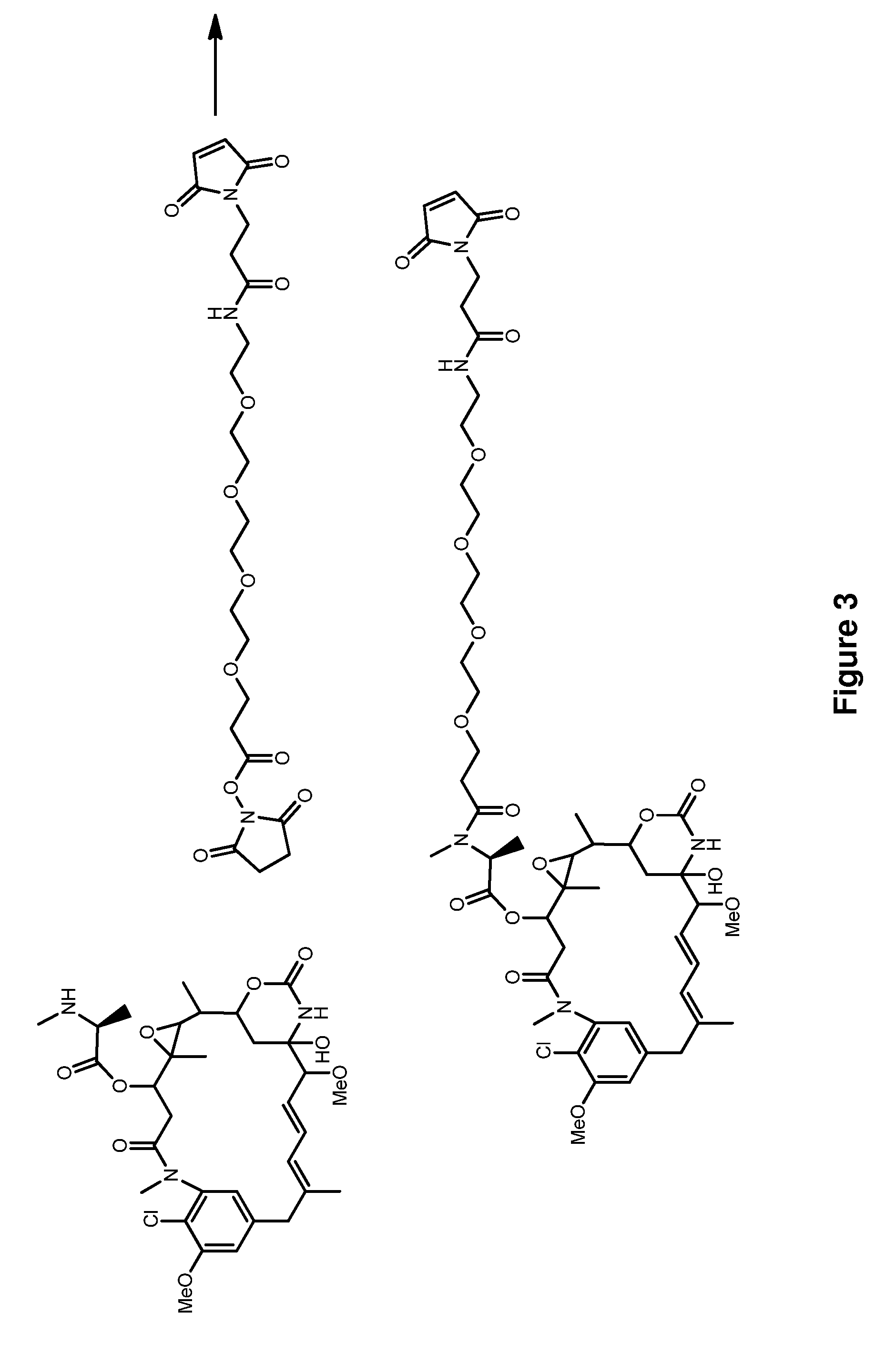Methods for the acylation of maytansinol
a technology of acylation and maytansinol, which is applied in the field of acylation of maytansinol, to achieve the effect of reducing formation and increasing the yield of an amino acid ester
- Summary
- Abstract
- Description
- Claims
- Application Information
AI Technical Summary
Benefits of technology
Problems solved by technology
Method used
Image
Examples
example 1
Preparation of DM1-SMe with Added 4a Molecular Sieves as Drying Agent
[0088]Maytansinol (50.1 mg, 0.0888 mmol), (4S)-3,4-dimethyl-2,5-oxazolidinedione (30.2 mg, 0.233 mmol, 2.6 eq), zinc triflate (133 mg, 0.366 mol) and 4A Molecular sieves (0.50 g) pre-dried at 250° C. under vacuum then cooled to ambient temperature, were added to a 10 ml flask. The contents were taken up in anhydrous dimethyl formamide (0.75 mL) to which was added diisopropylethyl amine (62 μL, 0.357 mmol). The mixture was stirred at ambient temperature for 24 hrs. A sample of the crude mixture was analyzed by HPLC, N2′-deacetyl-maytansine product accounted for 80% of the total HPLC area. The reaction mixture was diluted with 1:1 saturated NaHCO3:saturated NaCl (1.2 mL) and ethyl acetate (3 mL) mixed then filtered with celite, then washed with potassium phosphate buffer (1 mL, 400 mM, pH 7.5). The organic layer was dried with anhydrous magnesium sulfate, filtered then evaporated to form a yellow solid. To the solid ...
example 2
10× Scale Up of Example 1
[0089]The reaction in Example 1 was run on a 10 fold larger scale giving 490 mg (68%) of DM1-SMe.
example 3
Preparation of DM1-SMe without Added Drying Agent
[0090]Maytansinol (1.0 g, 1.77 mmol) was dissolved in anhydrous dimethyl formamide (15 mL) in a 25 mL flask which was cooled in an ice / water bath. After 2 min diisopropylethyl amine (DIPEA, 0.92 g 7.07 mmol) and zinc triflate (3.8 g, 10.6 mmol) were added with magnetic stirring, then (4S)-3,4-dimethyl-2,5-oxazolidinedione (0.913 g, 7.07 mmol) was quickly added and the mixture was stirred for 24 hrs. A sample of the crude mixture was analyzed by HPLC, N2′-deacetyl-maytansine product accounted for 65% of the total HPLC area. The reaction mixture was diluted with 1:1 saturated NaHCO3: saturated NaCl (25 mL) and ethyl acetate (40 mL), mixed then filtered with celite, and washed with saturated NaCl. The organic layer was dried with anhydrous sodium sulfate, filtered then evaporated. Residue was taken up in dichloromethane (30 mL) to which 3-methyldithiopropanic acid (1.1 g, 7.0 mmol) and N-(3-dimethylaminopropyl)-N′-ethylcarbodiimide hydro...
PUM
| Property | Measurement | Unit |
|---|---|---|
| v/v | aaaaa | aaaaa |
| particle size | aaaaa | aaaaa |
| volume | aaaaa | aaaaa |
Abstract
Description
Claims
Application Information
 Login to View More
Login to View More - R&D
- Intellectual Property
- Life Sciences
- Materials
- Tech Scout
- Unparalleled Data Quality
- Higher Quality Content
- 60% Fewer Hallucinations
Browse by: Latest US Patents, China's latest patents, Technical Efficacy Thesaurus, Application Domain, Technology Topic, Popular Technical Reports.
© 2025 PatSnap. All rights reserved.Legal|Privacy policy|Modern Slavery Act Transparency Statement|Sitemap|About US| Contact US: help@patsnap.com



